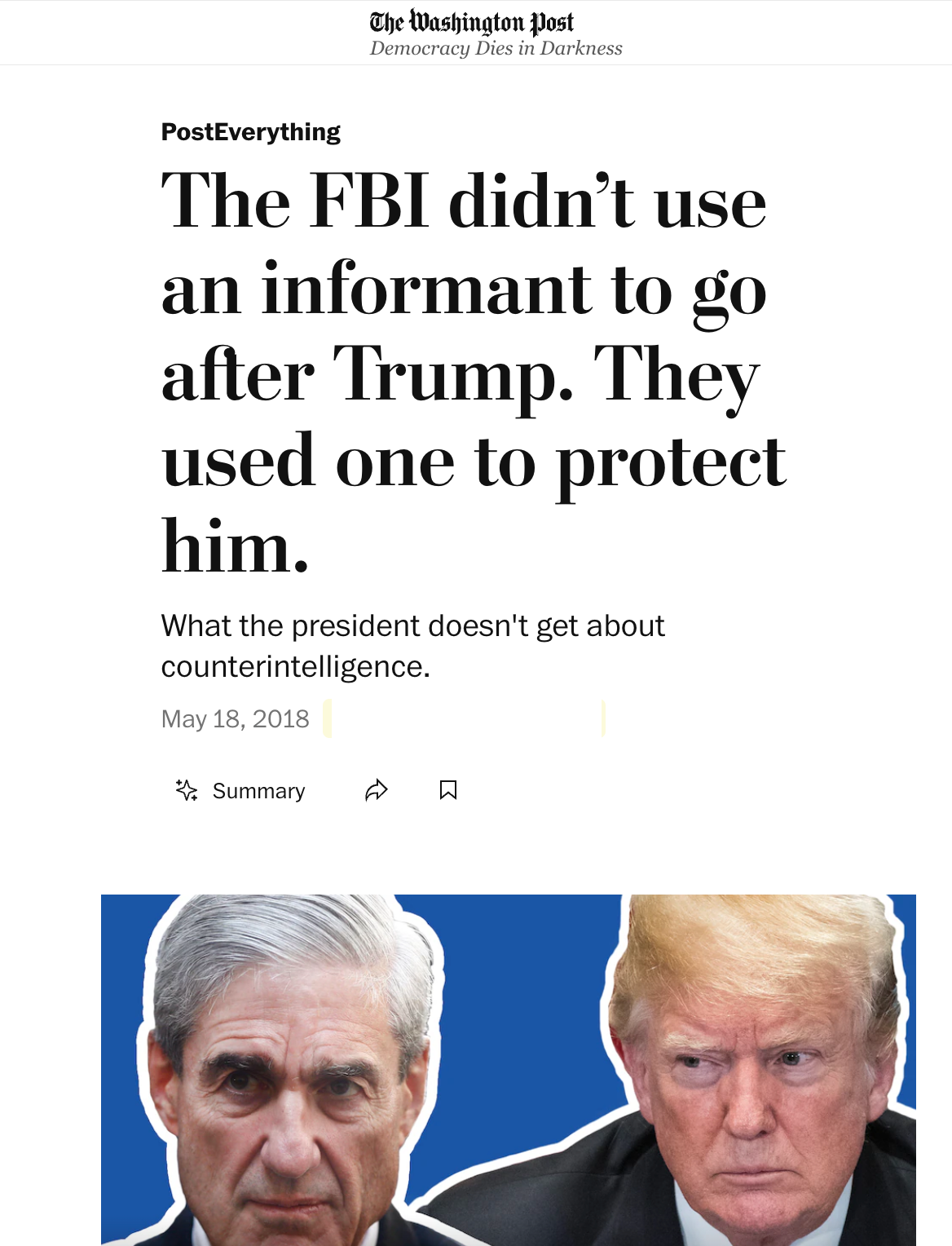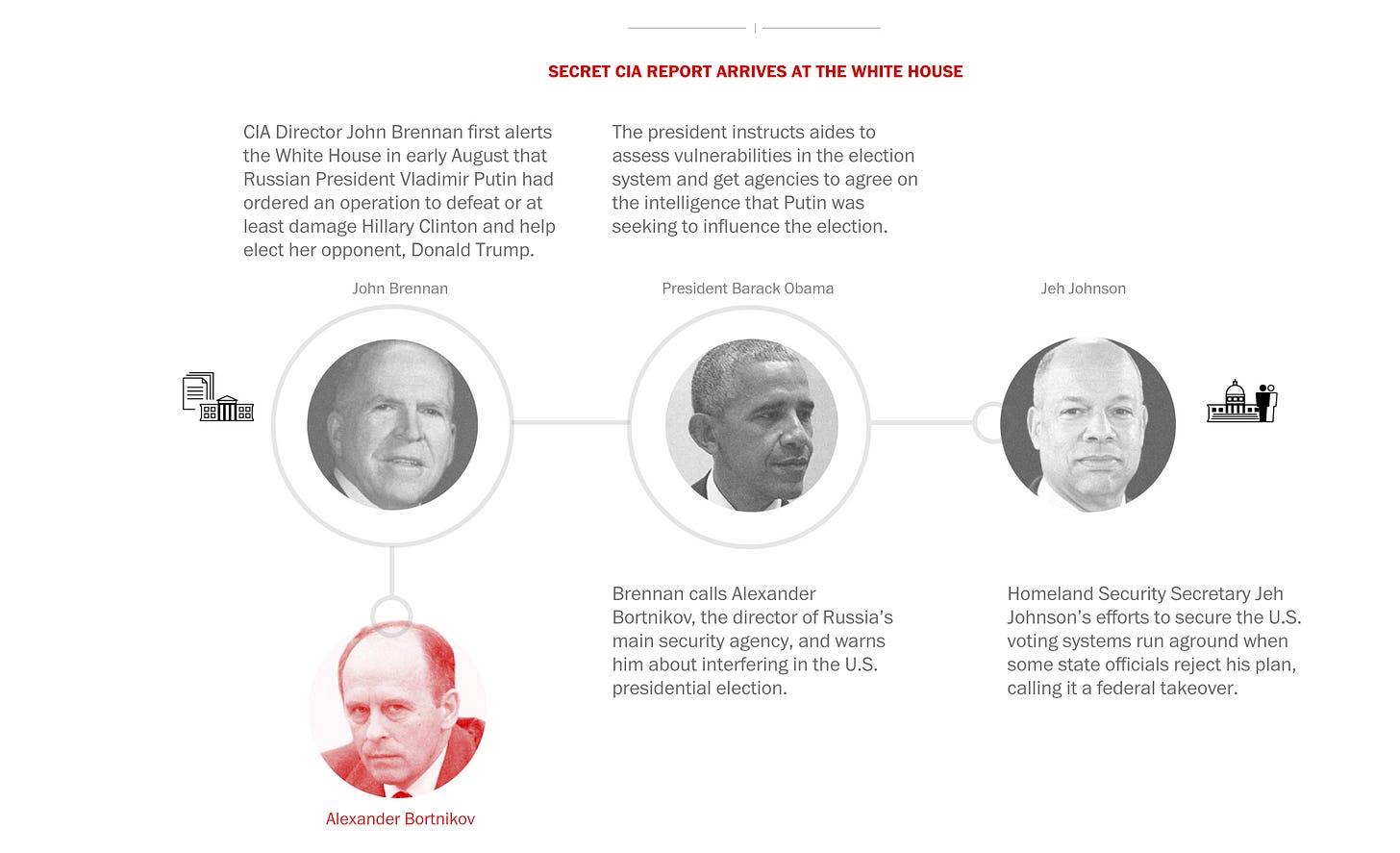The Deep State is Alive and Well, Selling the Same Old Lie: "Sources and Methods"
Journalists were once eager to hear secrets. As they proved again this week, they're now primarily gatekeepers, helping corrupt officials hide the ball
From “Gabbard overrode CIA officials’ concerns in push to release classified Russia report,” in the Washington Post this week:
The Trump administration pushed to unveil a highly classified document on Russia’s interference in the 2016 election after an intense behind-the-scenes struggle over secrecy, which ended in late July when Director of National Intelligence Tulsi Gabbard released a minimally redacted version of the report, according to multiple people familiar with the matter.
Gabbard, with the blessing of President Donald Trump, overrode arguments from the CIA and other intelligence agencies that more of the document should remain classified to obscure U.S. spy agencies’ sources and methods, the people said…
For sheer chutzpah, it’s hard to match Warren Stroebel’s crude hit piece. First, it isn’t news: many of us who wrote on Gabbard’s releases already reported that these documents came out over objections from other agencies. The crucial 46-page House Permanent Select Committee on Intelligence (HPSCI) report showing how officials like former CIA Director John Brennan cooked the books to argue Russia “aspired” to help Trump was declassified only after current HPSCI chairman Rick Crawford complained about it being “held hostage” at the CIA and “Trump interceded in early July,” as I put it weeks ago. Gabbard herself hinted at struggles with a still-formidable “deep state” in a speech on July 12th:
More to the point, the fact that she’s had to fight elements in the intelligence community (and others in government) just to get true material to the public is to Gabbard’s credit, not any kind of demerit. The Post, in a breathtaking spin job, simply took news Gabbard’s office is proud of, and spat it out as a negative.
“I love the Washington Post headline,” said Alexa Henning, Deputy Chief of Staff in Gabbard’s office. “Of course, the deep state is going to try to push back against us. When the CIA and others are leaking to the Post and the New York Times, that means we’re onto something.”
A source close to the original HPSCI investigation added: “Gabbard had to climb Everest to get this stuff out, and they’re giving her a hard time… Ridiculous.”
Amid this week’s media attacks, not one reporter noted the fight over Russiagate releases is ongoing, and involves material some intelligence officials are still determined to keep hidden. According to multiple people with knowledge of the probes, the “sources and methods” the CIA and other agencies are most concerned about don’t involve sensitive human assets or intelligence gathering, but bureaucratic tricks to burnish weak evidence or cover up bad practices. Burying the unclassified Steele dossier in the highest level of classification in the 2017 Assessment, pushing analysts to endorse conclusions based on unseen information, and using a “circle jerk” method of leaking to friendly media and then citing their articles in intelligence reports are among the practices at issue.
The recent press hysterics have to be understood in this context. Features decrying releases to taxpayers of documents written by public servants omit another fact: when you hear “sources and methods,” it’s a good bet the next word out of a reporter’s mouth is a lie. It’s nearly a 100% tendency:
Once, journalists denounced excessive secrecy. Until the Trump years, it was common to see editorials at papers like the New York Times railing against overclassification. In the last ten years, legacy outlets flipped the script, and reporters reveled in new roles as gatekeepers who helped national security officials hide the ball.
In the Russiagate scandal, whose long-suppressed issues are now exploding into view thanks to officials like Gabbard and FBI Director Kash Patel, the “sources and methods” line has been invoked countless times to stall public demands for disclosure. If you read these stories closely, you’ll notice that the same bylines from the same newspapers figure over and over in these whitewash jobs.
In May of 2018, when the House Intelligence Committee was on the trail of an informant who’d been deployed to spy on figures in the Trump campaign, the Washington Post cried that releasing information about the informant would “cross a red line of compromising sources and methods.” The paper even quoted Assistant Attorney General Stephen Boyd in saying it could lead to “severe consequences including potential loss of human lives.” Virginia Senator Mark Warner warned House colleagues it was “potentially illegal” to even try to learn the informant’s name. The man in question turned out to be Stefan Halper, a U.K.-based academic who’d been outed as a CIA operative in the pages of the New York Times in 1983.
It was all a bluff, just like the cries about “sources and methods” when investigators attempted to get hold of text messages between FBI lovers Peter Strzok and Lisa Page, and when Patel’s team of investigators tried to get documents pertaining to the faked FISA application used to spy on onetime Trump aide Carter Page. In the latter case, Patel’s assertions about FISA abuse were proven correct by an Inspector General investigation, but then-Congressman Adam Schiff and other House Democrats bemoaned what was described as an intrusion on “sources and methods” for “no legitimate purpose.”

The same thing happened in late 2017, when Patel — then heading a group of investigators at the House Intelligence Committee under Devin Nunes — attempted to get hold of information about who funded the infamous dossier by British ex-spy Christopher Steele. New FBI Director Christopher Wray bellowed, “We are dealing with very, very dicey questions of sources and methods, which is the lifeblood of foreign intelligence and our liaison relationships with our foreign partners.” It turned out there were no “liaison relationships” in play in that case, unless you count the one between Steele’s funders in the Hillary Clinton campaign and the FBI.
An important thing to note is that all of these “sources and methods” cries in the Russiagate affair helped cover up press negligence in addition to official malfeasance. The Steele case involved the unbelievable prospect that none of the many media outlets known to have possessed the dossier before release were aware it was paid Clinton campaign research. The FISA misuse story exposed a string of news agencies — including especially the Washington Post — which helped convey the inaccurate claim that Carter Page was an “agent of a foreign power.”
The Halper story made idiots of reporters (again, including from the Post) who claimed the “informant” was there to protect Trump, not spy on him. The Post went so far as to speculate that the “informant” who turned out to be Halper was “possibly someone who was already in Russian business or organized crime circles,” and a likely provider of other valuable intelligence that “will need to cease if made public.”
In hindsight, it’s incredible how far off-base some of these stories were, underscoring the enormous motive news organizations had in preventing the contradictory raw information from escaping.
Neither intelligence agencies nor media outlets worried about “sources and methods” when reporting on Robert Mueller’s indictments of GRU officers, or news about alleged “blackmail” material Russians kept on Donald Trump (which came from that highly classified annex briefed to the then President-elect), or conversations between Jeff Sessions and Russian ambassador Sergey Kislyak (announced cheerfully as gleaned from “signals intelligence”), or any of a dozen other episodes in which details about intelligence procedures were leaked to drive Trump-Russia mania.
Now it’s being reported as breaking news by the Post that “people familiar with the matter” say Gabbard “overrode” officials in the CIA and other agencies in her recent declassifications.
So far, though, the big “sources and methods” reveal in these releases is that the CIA pulled the key conclusions out of its backside. Prize “sources” proved to be an email with “no date, no identified sender, no clear recipient, and no classification,” a US ambassador reading a Russian “media item” saying Trump and Putin should “work together like businessmen,” and a “scant, unclear, and unverifiable fragment of a sentence” of unknown origin relayed secondhand to Director John Brennan, who tried to include it orally, from memory, nearly half a year after the encounter. The dangerous secret is that the CIA had fewer sources than a junior high newspaper, not awesome penetration of the Kremlin.
You wouldn’t know that reading the Post, which included hysterical quotes from Virginia Senator Mark Warner, who in a repeat of the Halper episode said Gabbard’s release “puts at risk some of the most sensitive sources and methods our Intelligence Community uses to spy on Russia and keep Americans safe,” and sends a message “the United States can no longer be trusted to protect the intelligence you share with us.” Author Stroebel added that “human sources reporting on Putin’s plans” are “among the agency’s most closely guarded secrets.”
He didn’t mention that the Post years ago wrote multiple features about Brennan’s alleged prize source “deep within the confines of the Kremlin,” even directing readers to a Komersant story that included his name. That was different.
Back then, the Post and most everyone else in the press were claiming the existence of detailed, specific intelligence about Putin’s evil plan to put Trump in the White House. From a June 23, 2017 report about the “bombshell” intelligence:
Early last August, an envelope with extraordinary handling restrictions arrived at the White House. Sent by courier from the CIA, it carried “eyes only” instructions that its contents be shown to just four people: President Barack Obama and three senior aides.
Inside was an intelligence bombshell, a report drawn from sourcing deep inside the Russian government that detailed Russian President Vladimir Putin’s direct involvement in a cyber campaign to disrupt and discredit the U.S. presidential race.
But it went further. The intelligence captured Putin’s specific instructions on the operation’s audacious objectives — defeat or at least damage the Democratic nominee, Hillary Clinton, and help elect her opponent, Donald Trump.
The Post offered a helpful infographic detailing how Brennan handled this amazing intelligence:
We now know this was false. The intelligence Brennan actually received at that time came from retrieved Russian material describing, in Brennan’s own words, “alleged approval by Hillary Clinton on July 26, 2016 of a proposal from one of her foreign policy advisors to vilify Donald Trump by stirring up a scandal claiming interference by Russian security services.”
That’s what Brennan briefed Obama about on August 3, 2016, and that’s what prompted Brennan to call counterpart Alexander Bortnikov of the FSB on August 4th, allegedly to warn him “not to meddle in the election,” as the New York Times put it. Speaking of sources and methods, information from intercepted Russian communiques mysteriously dried up after Brennan’s call.
“Sources and methods” was the cri de coeur after Edward Snowden told the world about illegal surveillance. It was George Tenet’s excuse in a 2002 letter to the Senate for not giving better WMD intelligence. Judith Miller dragged it out in her defense after her WMD stories blew up. It is the oldest and most pathetic trick in the media book. Now, it’s being thrust back in service, at a desperate time.
Expect new information soon not only on Russiagate, but on the underlying bad practices that made it possible. The intensity of the infighting taking place between releases gives some indication of how damaging this information is. The intelligence bureaucracy isn’t going down without a fight.




The best thing Obama & the Dems have going for them is the audacity of their corruption. Most people simply can’t wrap their heads around the idea that these people in power could be so venal and dishonest. Obama brought the worst of Chicago gutter politics to the national stage.
Your and Walter’s hypothesis that the media has a secondary motive to push bullshit into the AI algorithms is so deeply troubling I literally cannot take anything they say as honest. Incredibly insightful…and terrifying.